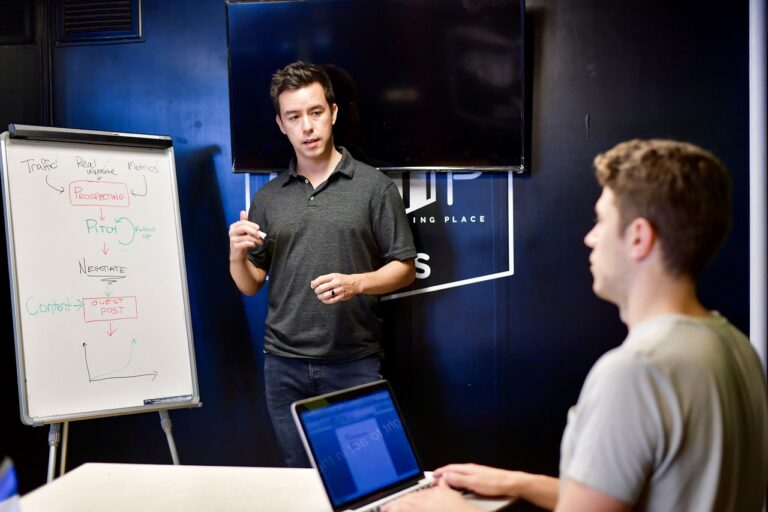How to Become a Better Leader in 30 Days
Embarking on a Leadership Odyssey
In an era where change is the only constant, the demand for dynamic and adaptable leaders has never been more pronounced. Industries evolve, markets shift, and technology advances at breakneck speed. Against this backdrop of rapid transformation, a true leader isn’t just someone who can manage a team or make tough decisions; a true leader must be an individual who can navigate these waters of change with vision, clarity, and resilience.
The landscape of leadership has seen a significant metamorphosis over the years. Once, it was enough for leaders to be authoritative, making decisions from the top down. Now, however, the most successful leaders understand the importance of collaboration, empowerment, and continuous personal growth. They recognize that leadership isn’t just about leading others but also about leading oneself. It’s about introspection, understanding one’s strengths and weaknesses, and constantly striving for betterment.
Some might argue that the nuances of effective leadership can’t possibly be encapsulated, let alone enhanced, within a mere 30-day period. And yet, the beauty of human potential lies in our ability to grow exponentially when we are focused, driven, and equipped with the right tools. Just as one can kick-start a fitness journey or embark on a challenge to learn a new skill in a month, so too can one take tangible steps to elevate their leadership capabilities in 30 days. This isn’t about overnight transformation but rather about laying a robust foundation for a leadership style that’s more insightful, more empathetic, and more effective.
The forthcoming journey through this article will not only provide a roadmap for aspiring and established leaders alike but also aim to ignite a spark of realization: that leadership, at its core, is a continuous journey of growth. Over the next month, by dedicating oneself to this process, one can begin to shift from a good leader to a great one. Whether you’re a seasoned CEO looking to refresh your approach or a new manager taking the reins of a team for the first time, the insights shared here are designed to provide a deeper understanding of the essence of leadership.
However, this isn’t just an academic exercise or a theoretical dive into leadership. The upcoming sections, distilled from years of observation and practice, provide actionable steps, tangible tools, and real-world examples that can guide leaders in making meaningful improvements. The overarching message is clear: Leadership isn’t a destination but a journey, and the next 30 days could be the most transformative leg of that journey yet.
As you read on, keep an open mind, be ready for introspection, and prepare to embrace a new chapter in your leadership narrative.
The Fundamentals of Leadership: A Refresher
Before diving into the actionable steps and nuances of how one can enhance their leadership skills within 30 days, it’s imperative to first ground ourselves in the foundational concepts of leadership. Just as a skilled artist must first master the basics before creating a masterpiece, a leader must understand the core tenets of leadership to effectively guide, inspire, and make impactful decisions.
The Definition of Leadership
At its most fundamental level, leadership transcends the simple act of guiding a group of individuals towards a goal. It’s an intricate dance of influencing, inspiring, and enabling others to contribute toward the effectiveness and success of the organizations of which they are members. Leadership isn’t just about holding a position of power; it’s about taking responsibility, setting the right example, and creating an environment in which everyone feels valued and heard.
Historically, leadership was often equated with authoritative figures who wielded power and made decisions. However, as organizational structures and societal perceptions evolved, so did the definition of leadership. Today, it encompasses a broad spectrum of roles, from the mentor who guides their mentee to realize their full potential, to the CEO who shapes the vision of a multinational corporation.
Characteristics of Effective Leaders
While leadership styles may vary, certain traits and characteristics consistently emerge among the most effective leaders:
-
Visionary: Effective leaders have a clear vision of where they want their team or organization to go. They not only see the bigger picture but can communicate it in a way that is compelling and relatable.
-
Empathetic: They understand and care about the individual needs and feelings of their team members. Empathy helps in building trust, understanding team dynamics, and fostering a positive work environment.
-
Adaptable: The ability to adapt to changing circumstances and pivot when needed is crucial. This includes being open to feedback and new ideas, even if they challenge the status quo.
-
Integrity: An effective leader is honest, transparent, and holds themselves to high ethical standards. They do the right thing, even when no one is watching.
-
Resilient: They face challenges head-on and rebound from setbacks. Resilience also involves demonstrating stability during turbulent times, providing a steady hand for the team.
-
Inspirational: Leaders inspire others not just through words, but through actions. They instill a sense of purpose and motivate their teams to achieve more than they thought possible.
The Dynamic Between Leaders and Their Teams
The relationship between leaders and their teams is symbiotic. Just as a conductor needs an orchestra to produce a symphony, a leader needs a cohesive, motivated team to achieve organizational goals. This dynamic is rooted in mutual respect, trust, and understanding.
Effective leaders create an environment where team members feel safe to voice their opinions, take risks, and make mistakes without fear of retribution. They understand the strengths, weaknesses, and motivations of each team member and tailor their approach accordingly. Moreover, they acknowledge and celebrate the achievements of their team, knowing that every success is a collective effort.
However, this relationship is not one-sided. Teams also play a role in shaping the leadership dynamic. They offer feedback, bring diverse perspectives to the table, and challenge leaders to think differently. It’s this collaborative push and pull that drives innovation and propels organizations forward.
In essence, leadership is not just about the individual at the helm but the intricate relationship between that individual and the team they lead. When this relationship is nurtured and both parties are in sync, it leads to unparalleled synergy, productivity, and innovation.
In the following sections, we will delve deeper into how leaders can cultivate and refine these fundamentals, using them as building blocks for the transformational journey of the next 30 days.
Week 1: Self-awareness and Personal Growth
The cornerstone of any effective leadership journey begins with introspection. Before one can lead others, it’s crucial to understand oneself: recognizing strengths, identifying areas for growth, and setting a clear vision for the future. The first week is dedicated to this internal exploration, paving the way for subsequent development in leadership competencies.
Day 1-3: Self-assessment
Tools and Methods for Self-assessment:
The journey of self-awareness begins by taking a deep dive into who you are as a leader, which often necessitates utilizing structured tools to assist in this exploration. Several renowned tools and methodologies can aid in this quest:
-
360-Degree Feedback: This tool involves gathering feedback from a variety of sources: peers, subordinates, superiors, and even oneself. It provides a holistic view of one’s leadership style, highlighting perceived strengths and potential areas of improvement.
-
Personality Assessments: Instruments like the Myers-Briggs Type Indicator (MBTI), the DiSC Personality Assessment, or the StrengthsFinder can offer insights into inherent personality traits, communication styles, and natural strengths.
-
Reflective Journaling: Taking time each day to jot down thoughts, reactions to daily events, and observations can be a powerful way to identify patterns, triggers, and biases.
Recognizing Your Strengths and Areas for Improvement:
Understanding oneself is not just about celebrating strengths, but also about confronting and acknowledging areas that require growth. The key here is balance. Recognizing and leveraging your strengths can boost confidence and enhance leadership effectiveness. Simultaneously, acknowledging areas of improvement doesn’t signify weakness; instead, it’s the first step toward growth.
Leaders might find that while they excel in strategic thinking, they might need to work on their empathetic communication. Or, they might be great at team collaboration but need to hone their decision-making skills. These revelations, while initially challenging, provide a roadmap for personal development.
Day 4-7: Setting Goals and Visualization
Crafting SMART Goals:
Once strengths and improvement areas are clear, the next step is to set tangible, actionable goals. The SMART (Specific, Measurable, Achievable, Relevant, Time-bound) framework ensures that these goals are clear and realistic.
For instance, instead of vaguely aiming to “improve communication skills,” a SMART goal would be to “attend one communication workshop in the next two months and implement one new learned technique in team meetings.”
The Power of Visualization and Affirmations:
There’s a profound psychology behind visualization. By mentally rehearsing and envisioning a desired outcome, leaders can prime their minds and bodies for success. Taking a few minutes each day to visualize achieving set goals can significantly enhance motivation and focus.
Affirmations, on the other hand, are positive statements that challenge and combat self-sabotaging and negative thoughts. Regularly repeating statements like “I am a confident and effective leader” or “Every day, I improve as a leader” can rewire the brain to believe these assertions and thus act on them.
To conclude, Week 1 is foundational in the 30-day leadership journey. By turning inward, leaders initiate the process of self-improvement. Understanding oneself forms the foundation on which other leadership skills are built, making this phase of introspection and goal setting pivotal for the transformative journey ahead.
Week 2: Communication and Relationship Building
Upon laying the groundwork of self-awareness, the subsequent phase shifts focus outward, emphasizing interpersonal dynamics. As many seasoned leaders will attest, effective leadership is often less about individual prowess and more about the ability to cultivate positive relationships and foster open communication within a team. Week 2, therefore, delves into the art of communication and the nuance of relationship-building.
Day 8-10: Active Listening
The Importance of Truly Hearing Your Team:
In the hustle and bustle of leadership responsibilities, there’s a stark difference between merely hearing and actively listening. While the former is passive, the latter involves full engagement, understanding, and processing what the other person is saying. Active listening is a pivotal skill, demonstrating respect, empathy, and genuine interest in what team members are sharing.
By actively listening, leaders can:
-
Understand underlying concerns or issues within the team.
-
Foster an environment where team members feel valued and understood.
-
Make informed decisions based on comprehensive input.
Exercises to Enhance Listening Skills:
Honing active listening skills may require practice. A few effective exercises include:
-
Reflective Listening: After someone speaks, reflect back what you’ve heard in your own words, ensuring you’ve understood their point correctly.
-
Avoiding Interruptions: Challenge yourself to engage in conversations where you don’t interrupt, allowing the other person to complete their thought entirely.
-
Note-taking: During meetings, jot down key points being discussed. This not only ensures you’re tuned into the conversation but also provides a reference for later.
Day 11-14: Constructive Feedback and Conflict Resolution
Best Practices for Giving and Receiving Feedback:
Feedback, when delivered appropriately, is a catalyst for growth. Here are some best practices:
-
Be Specific: Avoid vague comments. Instead of saying, “Your presentation lacked clarity,” you might suggest, “Incorporating more data visuals can make your argument more compelling.”
-
Be Timely: Offer feedback close to the event, ensuring the context is fresh for both parties.
-
Use the Sandwich Method: Begin with positive feedback, address areas of improvement, and then conclude with another positive point.
-
Encourage a Two-way Dialogue: When receiving feedback, listen without being defensive and ask questions for clarification.
Steps for Mediating and Resolving Conflicts:
Conflict is inevitable in any team environment. Effective leaders don’t avoid conflicts but address them head-on, ensuring they’re resolved in a manner beneficial to the team and organization.
-
Acknowledge the Conflict: Avoiding or ignoring it often exacerbates the issue. Recognize it and commit to resolving it.
-
Open Dialogue: Allow each party to express their perspective without interruption.
-
Identify the Root Cause: Often, the apparent issue is just the tip of the iceberg. Delve deeper to understand the underlying causes.
-
Generate Solutions: Brainstorm potential solutions collaboratively. This inclusivity can often lead to more effective resolutions.
-
Agree on Action Steps: Once a solution is identified, outline the next steps, ensuring clarity and consensus.
-
Follow Up: Revisit the issue after some time to ensure that the resolution has been effective and sustainable.
In summary, Week 2 underscores the essence of effective communication in leadership. By cultivating active listening skills and mastering the dynamics of feedback and conflict resolution, leaders not only foster a positive team environment but also lay the groundwork for enhanced collaboration, trust, and mutual respect.
Week 3: Empowerment and Delegation
The trajectory of a leader’s development now pivots from understanding oneself and building relationships to harnessing the collective strength of the team. It’s a critical juncture, as leadership isn’t about doing everything yourself—it’s about enabling and empowering others to achieve shared objectives. Week 3 dives deep into the realms of empowerment and delegation, exploring how leaders can amplify team performance by placing trust in their members and delegating effectively.
Day 15-17: Trusting Your Team
The Balance Between Micromanaging and Hands-off Leadership:
One of the perennial challenges leaders face is striking the right balance between being overly involved in tasks (micromanaging) and being too detached (hands-off leadership). Both extremes have pitfalls:
-
Micromanaging can stifle team creativity, hinder their sense of ownership, and erode trust. Team members may feel that their capabilities are constantly under scrutiny.
-
Hands-off Leadership, on the other hand, can lead to ambiguity, lack of direction, and feelings of neglect among team members.
The sweet spot lies somewhere in between, where leaders provide guidance and resources while granting the team autonomy to execute tasks.
Building Trust Through Consistency:
Trust isn’t built overnight. It’s a culmination of consistent actions, transparent communication, and mutual respect. Here’s how leaders can foster trust:
-
Be Predictable: Leaders who are consistent in their behavior and decisions create a stable environment where team members know what to expect.
-
Admit Mistakes: Demonstrating vulnerability and accepting responsibility when things go wrong reinforces credibility.
-
Value Input: Actively seek and acknowledge team input in decision-making processes.
Day 18-21: Effective Delegation
Recognizing Individual Strengths Within Your Team:
Effective delegation begins with recognizing the diverse talents within a team. By understanding the strengths, competencies, and aspirations of each team member, leaders can assign tasks that align with individual skills, thereby maximizing output and engagement. Regular team interactions, feedback sessions, and performance reviews can provide valuable insights into individual proficiencies.
Ensuring Clarity of Tasks and Expectations:
Delegation is not merely about assigning tasks—it’s about ensuring that the team has a clear understanding of what’s expected. Here are steps to ensure clarity:
-
Define the Task: Clearly articulate what needs to be done, the expected outcome, and its significance to the larger project or objective.
-
Provide Necessary Resources: Ensure that team members have the tools, information, and resources needed to execute the task.
-
Set Milestones and Deadlines: Breaking tasks into manageable milestones can make complex tasks more approachable and allows leaders to monitor progress.
-
Establish Communication Channels: Define how progress will be communicated and how often check-ins will occur. This ensures alignment and provides opportunities for course correction.
-
Encourage Questions: Create an environment where team members feel comfortable seeking clarifications or voicing concerns.
In essence, Week 3 accentuates the idea that leadership is not a solo endeavor but a collaborative symphony. Through trust and effective delegation, leaders can harness the collective potential of their teams, leading to better outcomes, heightened team morale, and sustainable success. The leader’s role shifts from “doer” to “enabler,” a transformation crucial for long-term leadership excellence.
Week 4: Vision and Adaptability
Entering the final stretch of this transformative month, leaders are presented with an intriguing juxtaposition: the forward-looking determination of vision and the malleable nature of adaptability. While these might appear at odds—where vision requires steadiness and adaptability demands fluidity—they are in fact two sides of the same coin. Together, they ensure that leaders not only set the direction but are also equipped to navigate the unpredictable terrains of leadership.
Day 22-24: Setting a Clear Vision
The Significance of a Shared Mission and Objectives:
At its heart, a vision acts as the North Star for an organization or team, offering direction and purpose. But more than that, a shared vision is a unifying force. When teams understand and believe in a common mission, they are more motivated, cohesive, and aligned in their efforts.
A shared vision:
-
Cultivates a sense of purpose among team members.
-
Aligns individual and team efforts towards common objectives.
-
Provides clarity in decision-making by acting as a reference point.
Communicating Your Vision Effectively:
Merely having a vision isn’t sufficient. It must be communicated clearly, passionately, and consistently to the team. Here’s how:
-
Articulate Clearly: The vision should be simple yet compelling, easy to understand, and memorable.
-
Use Stories and Analogies: Narratives can make abstract visions more relatable and vivid.
-
Reinforce Regularly: Integrate the vision into meetings, presentations, and everyday discussions. The more it’s reiterated, the more ingrained it becomes.
-
Lead by Example: Leaders should embody the vision in their actions, decisions, and behaviors.
Day 25-28: Being Adaptable and Receptive to Change
The Importance of Flexibility in Leadership:
In a rapidly evolving world, rigidity can be a leadership downfall. Markets shift, technologies advance, and unforeseen challenges arise. Leaders who can adapt, pivot, and evolve in response are better positioned to guide their teams through uncertainties.
Flexibility in leadership means:
-
Being open to new ideas and perspectives.
-
Revising strategies based on new information or changing circumstances.
-
Demonstrating resilience in the face of setbacks.
Techniques for Staying Resilient and Responsive:
-
Growth Mindset: Embrace challenges as opportunities for learning rather than threats.
-
Continuous Learning: Dedicate time to stay updated with industry trends, emerging technologies, and best practices.
-
Feedback Loop: Regularly seek feedback from team members, peers, and superiors to stay informed and adjust accordingly.
-
Mindfulness and Stress Management: Practices like meditation and deep breathing can help leaders remain calm and centered amidst chaos.
Day 29-30: Reflection and Continuous Improvement
Reviewing the Progress Made Over the Past Month:
As this 30-day journey culminates, it’s essential to pause and reflect. Consider:
-
What were the significant learnings and breakthroughs?
-
Where did challenges arise, and how were they addressed?
-
How have relationships and communication within the team evolved?
This introspection helps consolidate learnings and recognize areas that still require attention.
Setting a Path for Future Growth and Learning:
Leadership is an ongoing journey, not a destination. Even after these 30 days, the pursuit of growth should remain relentless. Consider:
-
Identifying new skills or competencies to develop in the coming months.
-
Setting new challenges or stretch goals for oneself and the team.
-
Seeking out mentors, courses, or workshops to continue the leadership evolution.
In summation, Week 4 reinforces that while having a clear and compelling vision is paramount, the ability to adapt to changing tides is equally crucial. As leaders navigate their paths, blending steadfastness with adaptability, and consistently seeking improvement, they sculpt themselves into dynamic, resilient, and visionary leaders—the very epitome of leadership excellence.
Case Studies – Learning from Real-Life Examples
Examining theoretical concepts and practices of leadership offers foundational knowledge. Yet, real-life case studies serve as the bridge between theory and practice, elucidating how abstract principles manifest in tangible scenarios. The following case studies spotlight leaders who underwent remarkable transformations in short timeframes, delving into the intricacies of their journeys, the outcomes of intensive personal development, and the challenges they surmounted.
Alan’s Reinvention: From Authoritarian to Collaborative Leadership
Background: Alan, a veteran in the tech industry, was known for his authoritarian leadership style. Accustomed to directing orders and expecting obedience, he faced escalating friction within his growing millennial and Gen-Z workforce.
Transformation Journey: Recognizing the changing tides, Alan embarked on a 45-day leadership program focusing on collaborative leadership. Through immersive workshops, he learned the significance of inclusivity, open dialogue, and mutual respect.
Outcome: Post-transformation, Alan’s team reported higher morale and increased job satisfaction. The culture shifted from one of apprehension to collaboration, and project delivery times improved by 20%.
Challenges & Overcoming Them: Alan’s initial challenge was his deep-rooted belief in his established style. Through mentorship and peer feedback within the program, he confronted his biases and committed to change. Regular reflection and seeking feedback became Alan’s tools for ensuring he remained on his new path.
Priya’s Leap: Embracing Emotional Intelligence
Background: Priya, a rising star in a global marketing firm, had a razor-sharp analytical mind. But her Achilles’ heel? Recognizing and navigating the emotional undercurrents of her team.
Transformation Journey: Priya’s 30-day foray into emotional intelligence training involved understanding her own emotions, developing empathy, and honing active listening skills. Role-playing scenarios and guided reflections were key components.
Outcome: As Priya integrated her learnings, meetings became more harmonious, and team cohesion soared. By acknowledging and addressing emotional dynamics, team productivity increased by 15%, and inter-departmental collaborations flourished.
Challenges & Overcoming Them: For Priya, the challenge lay in unlearning analytical detachment. Keeping a daily journal of emotional interactions and seeking mentorship from emotionally savvy peers helped her bridge the emotional intelligence gap.
Eduardo’s Transition: From Solo Performer to Inspirational Leader
Background: Eduardo, a celebrated financial analyst, was thrust into a leadership role due to his individual excellence. However, leading a team required more than individual prowess, a realization Eduardo grappled with as team performance dwindled.
Transformation Journey: Eduardo’s 60-day leadership immersion centered on vision-setting, effective delegation, and empowerment. By learning the difference between “doing” and “leading,” he evolved his approach.
Outcome: Eduardo’s team became a powerhouse in the finance department, with a 25% increase in innovative solutions proposed in the subsequent quarter. Employee turnover reduced, and the team secured two company-wide awards for excellence.
Challenges & Overcoming Them: Shifting from an individual contributor mindset was Eduardo’s initial hurdle. By setting clear boundaries, designating “thinking days” for leadership strategy, and actively seeking feedback, he refined his leadership style.
In essence, these case studies underscore that leadership transformation isn’t a matter of years but of intent, effort, and commitment. Each leader, regardless of their starting point, has the potential for growth. By engaging in intensive personal development, confronting challenges head-on, and being receptive to change, remarkable leadership metamorphoses are not only possible but are often the precursor to outstanding organizational outcomes.
Charting Your Future Leadership Landscape
As we culminate this exploration into the multi-faceted realm of leadership, one overarching theme emerges: leadership is neither static nor definitive. Instead, it’s a dynamic journey marked by continuous learning, self-reflection, and evolution. The pathway to becoming a more effective leader is not bound by the strictures of time, nor is it an exclusive domain for the select few. Whether in 30 days or 30 years, transformative shifts in leadership are achievable for anyone armed with intention, dedication, and the right tools.
The 30-day framework delineated throughout this article serves as a testament to the rapid progress leaders can make when they approach their development with focus and urgency. The segmented weekly approach, grounded in both foundational leadership tenets and progressive strategies, is designed to be holistic, encompassing the internal dimensions of self-awareness and the external dimensions of relationship building, vision-setting, and adaptability.
Through the lens of real-life case studies, we observed the profound impacts that intensive personal development can have on leadership outcomes. Leaders like Alan, Priya, and Eduardo are emblematic of the myriad ways in which leaders can confront their shortcomings, harness their strengths, and catalyze transformational changes not only within themselves but within their teams and larger organizations. Their stories serve as both inspiration and affirmation that change, however daunting, is within reach.
Challenges, as we’ve seen, are inevitable. Yet, they are not insurmountable barriers but pivotal moments of growth. Each obstacle faced and overcome carves out the refined silhouette of a more capable, compassionate, and visionary leader. Embracing these challenges, seeking feedback, and adopting a learner’s mindset are the hallmarks of leaders who leave indelible marks in their fields.
In retrospect, the call to action is clear: Do not wait for the perfect moment or the distant future to commence your leadership journey. Start now, start with intent, and be unwavering in your commitment. The next 30 days can be a transformative phase, setting the tone for a lifelong voyage of leadership excellence.
As the adage goes, “The best time to plant a tree was 20 years ago. The second-best time is now.” So too is the journey of leadership. Whether you’re a seasoned leader or embarking on your first leadership role, the invitation is open: Dive deep, explore, evolve, and emerge as the leader you’ve always aspired to be.
Additional Resources and Recommended Reading
The leadership landscape is vast, with a wealth of knowledge waiting to be explored. This 30-day journey offers a robust introduction, but leadership is a lifelong pursuit, and there’s always more to glean. Here, we present a curated collection of resources for those hungry to delve deeper into the art and science of leadership.
Books and Articles for Further Understanding
-
“Leaders Eat Last” by Simon Sinek: An exploration into the dynamics of trust and how leaders can cultivate a culture where people feel safe and empowered.
-
“Dare to Lead” by Brené Brown: Brown dives deep into the heart of vulnerability in leadership, showcasing how courage and connection pave the way for impactful leadership.
-
“The Five Dysfunctions of a Team” by Patrick Lencioni: Lencioni presents a captivating narrative that highlights the common pitfalls teams face and how leaders can navigate them.
-
“Harvard Business Review on Leadership”: A collection of thought-provoking articles from industry experts that touch on diverse leadership themes and challenges.
-
“What Got You Here Won’t Get You There” by Marshall Goldsmith: Goldsmith offers insights into the habits that hinder successful leaders and provides actionable advice to overcome them.
Tools and Apps for Continued Leadership Development
-
Evernote: An organizational tool that leaders can use to jot down reflections, insights, and lessons learned on their leadership journey.
-
MindTools: An app offering a plethora of resources on leadership skills and management, from articles to interactive quizzes.
-
Headspace: Mindfulness and leadership are closely linked. Headspace offers guided meditations to enhance focus, reduce stress, and promote a balanced leadership approach.
-
360Reach: A personal branding assessment tool that aids leaders in understanding how they’re perceived, providing invaluable feedback for growth.
-
Trello: Effective leaders need to manage tasks and projects efficiently. Trello assists in organizing tasks, setting goals, and monitoring progress.
Workshops and Seminars for Deeper Immersion
-
Dale Carnegie Leadership Training: A renowned program that emphasizes interpersonal skills, team dynamics, and effective communication.
-
Center for Creative Leadership: They offer an array of workshops targeting specific leadership challenges, from driving innovation to leading cross-generational teams.
-
Toastmasters International: While primarily known for public speaking, Toastmasters also focuses on leadership development, offering a safe environment to practice and refine leadership skills.
-
Leadercast: An annual one-day leadership event that brings together acclaimed leadership experts from around the globe.
-
MIT Sloan Leadership & Management Courses: For those seeking an academic approach, MIT Sloan offers intensive courses touching on the latest in leadership research and strategies.
Venturing into these additional resources will undoubtedly enrich your understanding and expand your leadership toolkit. As with all journeys of significance, leadership development is not about the destination but the continuous journey of growth, exploration, and self-improvement. These resources will serve as valuable companions as you forge ahead, marking milestones and setting new horizons in your leadership odyssey.







